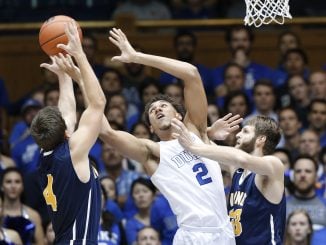Last season, Duke pitcher Eli Herrick was having a career year in his senior season with the Blue Devils. He had allowed just one run in his first eight appearances for a 0.93 ERA, was striking out 1.3 batters per inning, and opponents were hitting just .206 off him, 46 points lower than his junior year.
With a fastball that hit the mid-90s and off-speed stuff that, according to tracking software, had one of the biggest breaks on the Duke team, Herrick seemed like the type of late-developing senior who would entice a team to take a chance on him in a late round of the MLB Draft.
Then the pandemic changed things significantly — for Herrick, for MLB and, possibly, for future generations of aspiring big leaguers.
“It seems like a long time ago,” Herrick said. “As soon as the pandemic hit, it became pretty apparent pretty quickly that things were going to be different as far as how the draft took place, how everybody was presenting themselves to MLB teams, how MLB athletes were presenting themselves to their teams that they were now separated from. It was kind of a reshifting in college baseball.”
The draft was slashed from 40 rounds to a mere five, ending Herrick’s hopes of getting selected, especially since he only had a partial senior season to show teams and an incomplete data profile.
“I was a midweek guy,” Herrick said of the bulk of his Duke career.
In the college baseball calendar, teams gear up for big weekend series against conference opponents and also play Tuesday or Wednesday tuneup games against lower-profile nonconference foes. So while Duke shared the Durham Bulls’ DBAP, complete with all of the parent club Tampa Bay Rays’ tracking software and devices, for weekend games, midweek games were often at smaller venues that didn’t have such high-tech player evaluation tools.
“I’d sit down with my coach, and he’d tell me what I needed to work on,” Herrick recalled, “and I’d say, ‘I did that in my last game.’ But it was at NC Central, so we didn’t have data to show that.”
Herrick decided to do something about it.
“I was trying to get drafted, obviously. I’d had a great senior year and obviously would have liked to keep playing, but the draft comes and goes and I don’t get taken,” he said. “I’m looking around — my numbers were pretty good. My stuff looks a lot better this year. How come that didn’t equate to getting signed or getting some kind of offer? I didn’t get a lot of answers to that, and there were a lot more answers that weren’t where I wanted them to be. So it looked like there was an opportunity.”
Herrick co-founded a company to put the power of analytics into the hands of those whose numbers are being measured.
The company, StatStak, bills itself as “the epicenter of athletic data” and “an athlete-centric data storage solution.”
“I’ve seen the emphasis on sports data, especially capturing everything that’s happening on the field — from the (pitch tracking software) TrackMan’s to the (wearable technology) Blast’s to the force sensors,” he said, “and I saw the disconnect between how it’s used internally and how athletes are getting to see that and have that be promoted.”
The idea is to allow athletes to have all of their performance data in one place so they can present an analytic resume to teams that may potentially draft or sign them.
Before anyone writes off Herrick’s venture as a sour-grapes complaint from an undrafted player, consider that his co-founder is former Duke teammate Graeme Stinson, who was drafted in the fourth round in 2019 and is working his way up the Rays organization. He sees just as much value in StatStak for pro players, if not more, since the number of ways he’s being tracked has expanded exponentially since he entered organized professional ball.
“With performance being measured by so many data sources, it’s essential for me to have all of my data in one place,” Stinson says on the company site. “We built StatStak to solve that problem, putting all of my data in my pocket and getting my coaches and me on the same page.”
StatStak has signed up several teams to participate in the venture, creating a sort of credit bureau for baseball analytical data. Herrick realizes that there’s still a long way to go before achieving his and Stinson’s goal.
“I envision that when you go to a tournament or a showcase or a school pro day, you bring your StatStak account with you,” Herrick said. “You have all your stats and metrics. It would be like having a VIN number on your car or having a Social Security number when you go to the hospital. You plug in that one code and all your past information is in that one place.”
So, while Herrick’s original dream may have been to play the game that he loved, it appears he’ll instead be changing it for the better.



